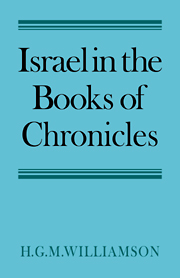PART ONE - The Extent of the Chronicler's Work
Published online by Cambridge University Press: 26 February 2010
Summary
For the past 150 years, the view has reigned almost unchallenged that the books of Chronicles, Ezra and Nehemiah were originally all part of a single work. Although there had been some who earlier hinted at this idea, it was in 1832 that L. Zunz set out the evidence which, with later additions and refinements, convinced the overwhelming majority of scholars. Confirmation of this statement may be found by reference to virtually any modern commentary or introduction written from that time down to the present day.
Four main arguments have been advanced in favour of this view:
The presence of the opening sentences of Ezr. at the end of 2 Chr.
The evidence of 1 Esdras, which starts at 2 Chr. 35 and continues without interruption into Ezr.
The similarity between the books in style and choice of vocabulary.
The similarity of outlook, interests and theology.
Whilst it may be argued that these points have a cumulative effect, they must in the first instance, at least, be examined individually. It should be stressed that it is recognized that these books do all treat similar themes and interests, and that there is a chronological continuity that none can gainsay. Whether these themes are treated from the same angle, however, or whether these points are sufficient to prove identity of authorship is another question.
- Type
- Chapter
- Information
- Israel in the Books of Chronicles , pp. 5 - 6Publisher: Cambridge University PressPrint publication year: 1977
- 1
- Cited by



